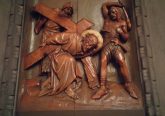Satan and the Devil
Do Catholics believe in the existence of Satan? Is Satan the same as the devil?
A significant number of Christians do not believe in Satan. They consider him representative of evil, but not an active being. Yet the Catholic tradition has long acknowledged the existence of Satan and associated with him evil presences that seek to undermine humanity’s relationship with God.
VARIOUS NAMES
The Evil One has various names. The most common terms include Satan, from the Hebrew verb meaning “to oppose,” and the devil, from the Greek word for “accuse” or “calumniate.” These names are used frequently in the Bible, and Satan, Lucifer, the devil, the tempter, or the Evil One are usually synonymous in the Scriptures and Christian writings.
Demons and other evil spirits are related to the Evil One. When Satan rebelled against God, many angels joined in his rebellion. These fallen angels, now called demons, share in Satan’s opposition to God and actively work to tempt and deceive humanity.
ANGELS AND DEMONS
Belief in Satan is based on the understanding that God created both the angelic and the earthly. We confess this whenever we say the Creed: “I believe in … things visible and invisible.”
Satan, one of the invisible creatures, is a fallen angel. The Church teaches that God created the devil and other demons as good, as angels, but they became evil “by their own doing.” Through their own choice, they “radically and irrevocably rejected God” (Catechism of the Catholic Church, 391-392).
Though invisible, the devil and other fallen angels are no less real. Pope Paul VI related that “evil is not merely the absence of something but an active force.” There are many demons, but there is principally one (Satan) who rules. Together, they comprise “a whole mysterious world, convulsed by a most unfortunate drama about which we know very little” (General Audience, November 15, 1972).
GOD SAVES
Jesus came to save humanity from sin and death. His name means “God saves.” The early Church interpreted His coming as the means to destroy Satan and his works. As St. John relates, “The Son of God was revealed to destroy the works of the devil” (1 Jn. 3:8). It is fitting that Jesus went head-to-head with Satan just before beginning his public ministry. After successfully enduring three temptations, Jesus said, “Get away, Satan!” and the devil left him (Mt. 4:1-11).
But this was not the end of Jesus’s dealing with the Evil One. Many of His healings in the Gospels involved persons possessed by the devil. Notice how Jesus interacts with the forces of evil: He commands the evil spirits to leave. Whether one or many, they depart. In a most dramatic scene, Jesus sends demons into a herd of pigs, who then rush into the sea where they are drowned (Mt. 8:28-32).
EVIL DOES NOT WIN
Satan and his demons are powerful, but this does not mean they cannot be defeated. Through Jesus’ death and resurrection, Satan has been overcome. The Church, through Christ, has power over evil. This is seen in the blessings offered by the Church and in special rites called exorcisms that sanctify persons and objects, commanding evil to flee.
Why God has permitted Satan to have influence here on earth is not known, but we need not fear. Through the power of Christ, we can have victory over Satan’s temptations. We need only call upon Him in faith, as we pray so often in the Lord’s Prayer, “Lead us not into temptation but deliver us from evil.”
 Father David Endres is professor of Church history and historical theology at Mount St. Mary’s Seminary & School of Theology.
Father David Endres is professor of Church history and historical theology at Mount St. Mary’s Seminary & School of Theology.
This article appeared in the October 2023 edition of The Catholic Telegraph Magazine. For your complimentary subscription, click here.













